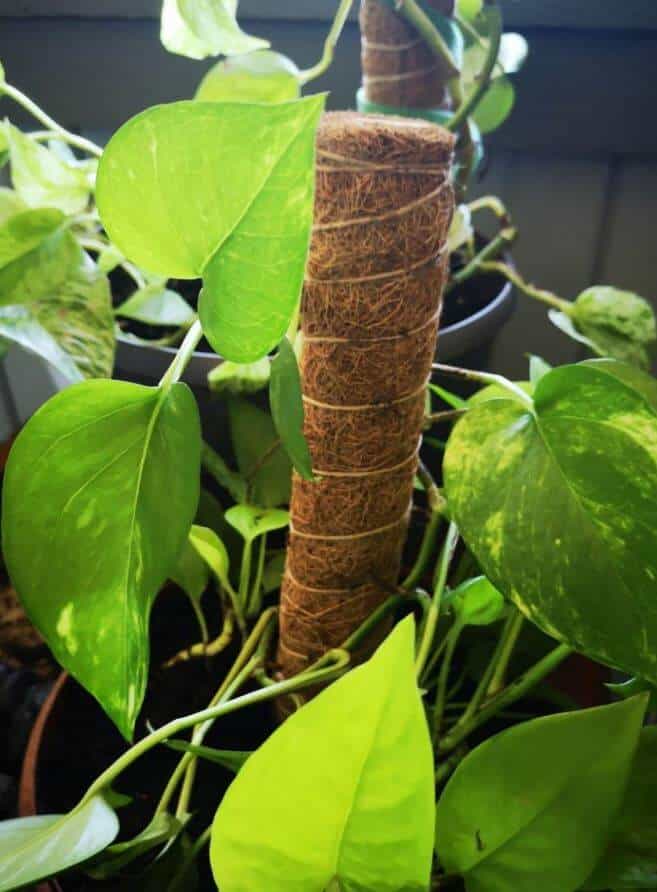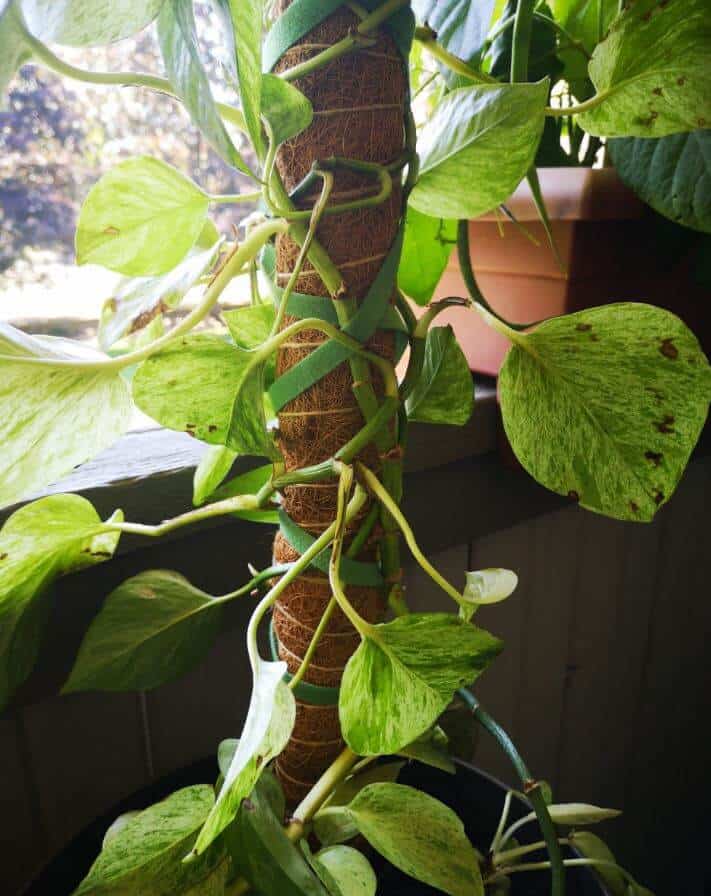Last Updated on July 29, 2023 by a Friendly Gardener
The very popular pothos houseplant is a natural climber with vines veering off in multiple directions to explore the environment. But when cultivated as a houseplant, this delightful green jewel can do with a bit of support and the moss pole is a common choice both aesthetically and for efficacy.
The Advantages of Using a Moss Pole for Your Pothos

Using a moss pole is not purely an aesthetically motivated choice. Moss poles for vining and climbing plants aid our green friends in flourishing. Several benefits of using a moss pole include:
-
Replicating the pothos plant’s natural habitat
The use of a moss pole aids in mimicking a pothos plant’s natural habitat. These are climbing plants that in the tropics will scale tree trunks or branches in search of a light source. Placing a moss pole in your plant’s container encourages the plant’s natural growth habit and may render your plant just a bit happier despite its indoor environment.
-
Contributing to a healthier growth habit
The pothos tends to produce larger foliage when in its native habitat and leaves may even produce characteristic splits or fenestrations. A climbing growth habit stimulates the development of the plant’s root system, which in turn can contribute to more vigorous growth.
-
Aesthetics
Although moss poles offer solid support for a climbing plant’s growth habit, moss poles are also decorative and can add an attractive natural element to your indoor garden collection. Poles are vertical and can add height to your collection and a special spot in your indoor décor.
-
Air circulation improvement
A moss pole will keep your vining plant from resting on the ground which means foliage will benefit from improved air circulation. Better air circulation aids in contrasting the accumulation of excess moisture and rotting issues that may develop as a result.
When opting to introduce a moss pole into your indoor garden, you can either purchase one from your local garden center or create your own.
Making Your Pothos Planta Moss Pole

To create your moss pole, gather these materials:
- gloves
- scissors
- a PVC or wooden pipe that measures two to four inches in diameter
- sphagnum peat moss for covering the pipe
- fishing line or gardening twine
- a spray bottle that you have filled with water.
Once you have gathered your materials and tools, you’ll be ready to create a moss pole for your pothos plant.

- Begin by preparing your PVC or wooden pipe. While the ideal diameter should measure between two and four inches, the height of your pipe needs to accommodate your plant’s growth habit. PVC poles are resistant to water and moisture, but if you are using a wooden pole, you may want to sand and paint it before preparing it for the plant to give the pole added moisture resistance.
- You also need to hydrate the sphagnum moss you are using. Place the moss in a container filled with water for approximately fifteen minutes to hydrate it. Once it has soaked, squeeze out excess water so that the moss is damp but not soggy or saturated.
- Once the moss is hydrated, begin to attach it to the pipe. You need to wrap the pipe in the sphagnum moss so that it is evenly wrapped around the entire length of the pipe. The layer of moss should be thick enough for your pothos to be able to attach to it as the vines begin their climb. Once wrapped, secure the moss to the pipe using the fishing line or garden twine. Do not wrap the twine too tightly around the moss as this may damage it and eventually prevent healthy growth. Another option is to glue or staple the initial layer of moss onto the pipe.
- Now comes the interesting part as you must attach your pothos plant to the moss pole. Begin by positioning the moss pole in your pothos plant’s container. When doing so, make sure you do not damage the pothos plant’s root system. Once you have secured the moss pole in place so that it offers stable support, you can begin to arrange tour pothos plant on the moss pole. Beginning with the longest vine, wind it around the pole in a natural pattern. Continue with other vines. You can secure the pothos vines to the pole using additional fishing lines or garden twine. Continue wrapping until all vines have been secured in place on the moss pole.
When wrapping the vines around the pole avoid bending them too much to prevent breakage or damage to the vines. If you acquire a ready-made moss pole, it will probably come with floral pins or Velcro strips to help you attach the vines and keep them in place.
As your plant adjusts to its new support structure, the aerial roots found on the vines will attach themselves to the sphagnum moss to aid in supporting the climbing vines in place,
Caring for a Moss Pole

Once you have acquired or created a moss pole for your pothos to climb on, you will need to take care of it, so your plant remains healthy. Follow these easy tips to keep your pole and pothos plant thriving:
- The sphagnum moss needs to be kept moist to provide the ideal climbing structure for your pothos. Mist the moss pole regularly with a spray bottle filled with water. Avoid misting your pothos, opting to mist the pole instead. It should be moist but never soggy.
- As your pothos continues to grow, train new growth in an upward direction and prune your plant as necessary to maintain a pleasing shape. Trim off any overly long vines to encourage bushier growth. Use clean, sterilized gardening shears when pruning.
- Care for your climbing pothos by watering as needed and by fertilizing monthly during the growing season with a balanced, liquid fertilizer for foliage plants.
- Examine your plant’s growth to verify it and when it will need to be repotted to a larger container or a longer pole.
Potential Moss Pole Issues

Watch that the moss on your pole does not dry out making sure to mist it often enough for it to remain damp. Examine your plant for pest infestations and treat your pothos with insecticidal soap or neem oil at the first sign of infestation. Finally, look for mold or rotting on your plant as well as on the pole. This will generally occur if the plant is overwatered or has poor air circulation.

